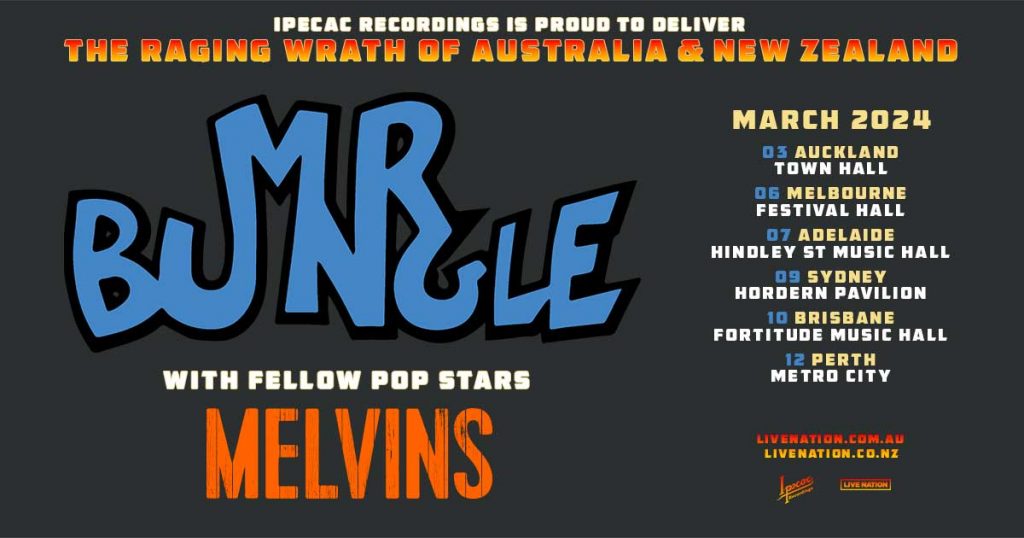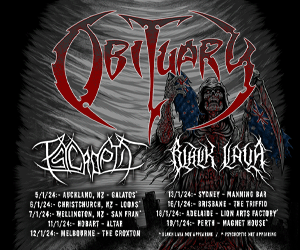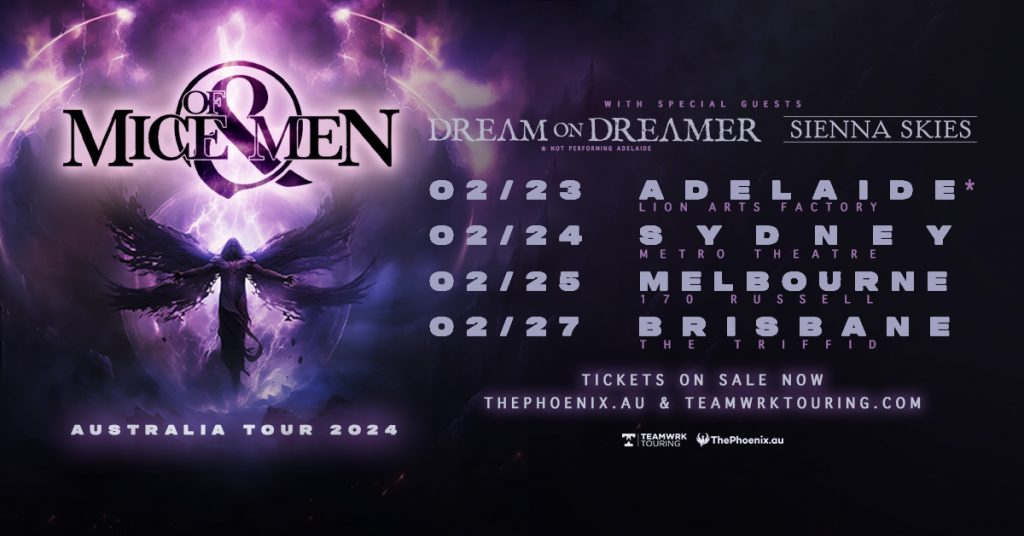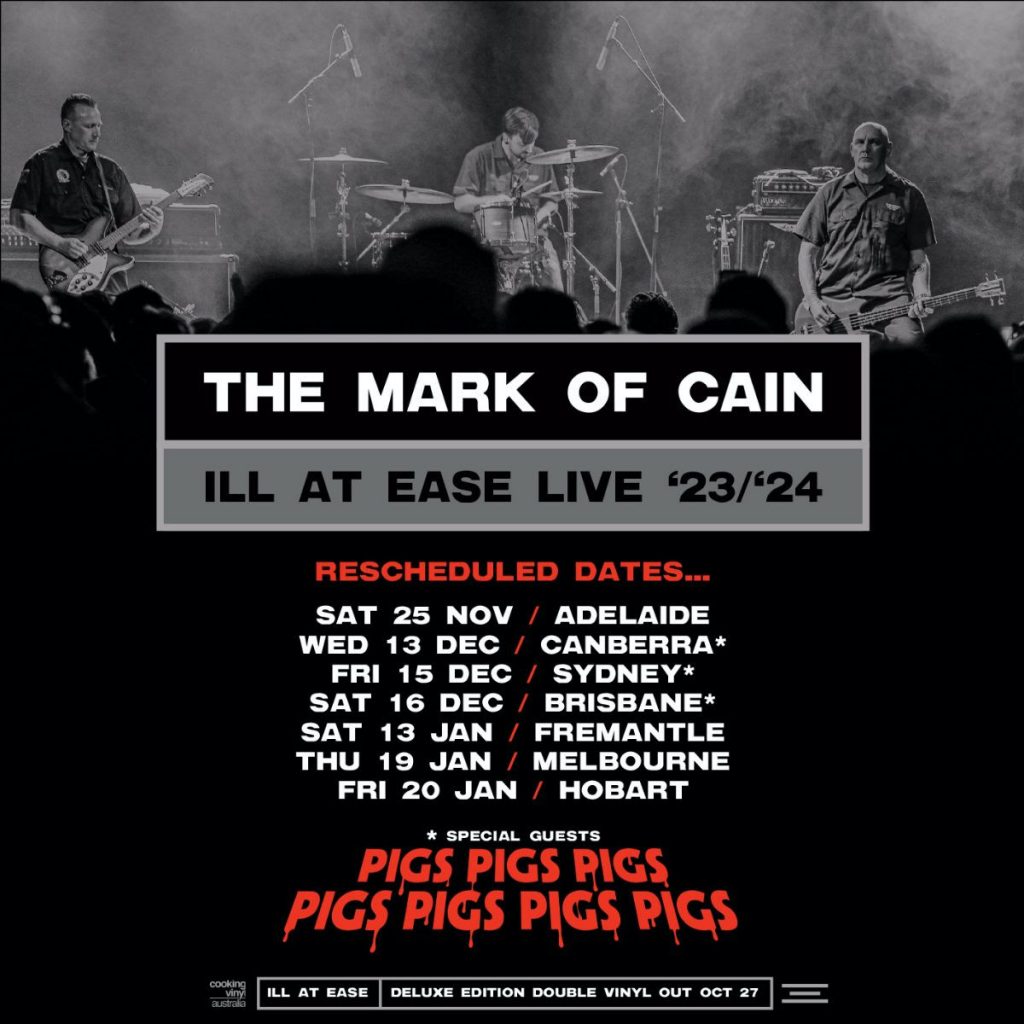Though we aren’t inundated with review CDs any more (a what?), our inboxes are crammed …
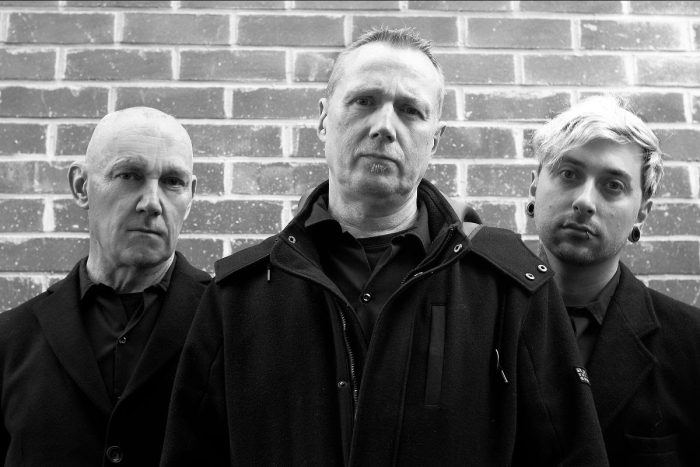
When The Mark of Cain’s third album Ill at Ease was released in 1995, it grabbed the Australian music scene by the throat.
MORE: NOFX: Fat Mike and his Eternal Footwaer Gratitude REVIEWS: CLOWNS: ENDLESS // BLINK-182: One More Time… // POPPY: Zig // MAGNOLIA PARK: Halloween Mixtape II // LUNE: The Change Around Us & The Change In You // PINCER+: Hunting God Tapes, Vol. 2: Romance
Crafted along with Henry Rollins in the producer’s chair, Ill at Ease was percussive and aggressive, driven by flinty, hardcore-influenced riffs, militaristic drumming, snarled vocals and a crushing groove, it was one of the most intense and heavy albums by an Australian act to ever break the Top 100. For the band who made it, Ill at Ease was a breakthrough that led to appearances on major festivals and film soundtracks, elevating them to national headline status after a decade at the forefront of the noise rock/hardcore underground.
28 years later, Ill at Ease remains a landmark, a momentous and visceral explosion of outsider rock as powerful and influential as when it was first released. As the band goes out on the road again to tour the album’s legacy, we approached vocalist John Scott and the album’s producer Henry Rollins with some questions to give us an insight into this awe-inspiring release.
HYSTERIA: Given that Ill at Ease was your third album, was there ever a sense going in that it would be something of a breakthrough release?
JOHN SCOTT: I think once we’d finished we all thought it was a pretty good representative package of what TMOC were about, but the impetus to getting it out was just us wanting to get the new songs and material out there. There was no, “Wait till they hear this” sort of thing going on. Main thing for us was always about the journey of recording the songs and having someone produce who we looked up to as a performer and writer, was cream on top of that experience.
H: When did you become aware that Rollins was interested in producing your album?
JS: I think it was after he’d received Battlesick, Rollins rang Tim Pittman (Feel Presents: Rollins Band promoter) and asked to get in touch with us, as he wanted to put the record out on his label 2.13.61. That started the relationship and when we signed with RooArt to record and release Ill At Ease, we took up Henry’s offer to produce us sometime if we wanted. Chris Haskett from the Rollins Band had also expressed interest as well.
H: How did TMOC come onto your radar and what was it about them that made you want to work with them in the studio?
HENRY ROLLINS: I believe it was at some point in 1992, I was in Australia doing band shows and TMOC played on one of the bills. I thought they were great. After the show, they gave me their Battlesick album. I liked it as soon as I heard it. In 1994, we were back in Australia and we played more shows together. By then I’d heard The Unclaimed Prize, which I thought was great as well. At some point in 1995, they asked if I would help them mix their next record, this would have been Ill At Ease. They sent me either demo versions of the songs or rough mixes and I thought they were the best songs they’d ever done.
I do recall at one point we discovered a finished mix of Walk Away was accidentally erased by the engineer (sorry Tony), and it was the one time I saw Rollins really angry. He kept his cool about it but it was like the rage was bubbling beneath the surface.
[ John Scott ]
H: What level of preparation was there ahead of going in to record and what was the working relationship like in the studio? Are there any particular moments that really stand out for you?
HR: I went to Adelaide and got into the studio with the engineer and we went through the tracks, which were already recorded, so basically, I was there to work on EQ and make the final mixes. The Scott brothers are very hard working and not new to song writing or the studio, so the tracks were really done, just in need of a final mix. Kim and John would go to their jobs and I’d work on a song a day. They’d come by after they got off work to listen to what we’d done and give us their notes. The engineer and I were either right on the nose with what they were looking for or close enough to where we could get it done while they were in the room with us. The songs were, as I said, very fully formed. The challenge was the snare drum sounds were not always consistent through the songs so I’d have to make handwritten notes and ride level and make adjustments as the song played and the board was manual and I was doing very active mixes, so it was literally “all hands on deck” as we had to manually move guitar levels. I think Point Man and The Contender proved to be most challenging but we got it done. Both tracks have so much happening, to make the songs have maximum impact, we had to do a lot of working on the fader levels. I think they made a really good record. I just helped at the end.
JS: We had rehearsed all the songs beforehand, and we went in and recorded what we had. There was no writing on the spot – these were all fully formed songs.
We all worked well together; I mean it’s always a bit nerve wracking recording, making sure there are no mistakes. But there’s a workman-like atmosphere with what we needed to do and we all got along. Tony Nesci, the engineer and ourselves had previously worked together before and so we all knew one another. The studio was in Tony’s house. Tony was never happy when Kim wore his ripples as they would leave lines in his carpet! Plus, we all knew to look away when Tony plugged in his special EQ formula into his DAT system, as that was a big secret and was only in his head. So, we’d all worked out how to interact with one another.
I do recall at one point we discovered a finished mix of Walk Away was accidentally erased by the engineer (sorry Tony), and it was the one time I saw Rollins really angry. He kept his cool about it but it was like the rage was bubbling beneath the surface. So we had to completely redo the mix, complete with about four of us stretched across the mixing console bringing audio in and out, riding snares, adjusting reverb sends at certain points in the song, it was a complicated dance of arms and hands, and make one mistake and you have to start all over (which happened).
And of course, we had our time with Henry, just chatting, asking about Black Flag, Bad Brains, other bands he’d played alongside of, literary influences, films, music – a really nice time. Call it a personal spoken word, but with the added interaction of being able to ask questions. That was really fucking awesome.
John Scott builds soundtracks disguised as songs, so before you hear any lyrics, the mood is already set.
[ Henry Rollins ]
HR: John Scott builds soundtracks disguised as songs, so before you hear any lyrics, the mood is already set. The top parts of the songs are often what seems to be a long instrumental but it’s setting the mood. You’ll hear this used to great effect on The Contender. We really worked on putting a lot of care into what we could do to build these parts of the songs up so when the vocal came in, the listener has been prepared. Hopefully, we were able to maximize all the potential in the tracks. Had I been there when they were cutting basic tracks, I wouldn’t have changed a thing and I’m quite sure they wouldn’t have let me anyway. The Scotts have a fully realised vision for what they want to put across with their music.
H: Was there any plan for you to collaborate or make a guest appearance on any of the tracks?
HR: As far as I can remember, that was never brought up. When I got out there, all the tracks were done and I don’t think there was anything they could have added to make the album better. I think it’s a completely realised batch of songs and anyone else showing up on it only would have lessened the impact.
H: Was the shift to a more percussive and aggressive sound a natural progression, or was it something that was encouraged in the studio?
JS: We’d been moving towards that percussive aggressive sound for a while – Battlesick, while melodic in places, had more than a few of the more percussive, hardcore type riffs as well. The songs on Ill at Ease were really indicative of the band learning more, exploring more and coming into their own. Big Black was a big influence on me, and I loved their bombastic sort of style, and I think that was part of it from a percussive point of view.
H: How did you approach working with Henry? What was his level of input to the music? How much did that change the songs you had at that point?
JS: We’d written everything before Rollins came over, and we’d recorded most of all tracks except the vocals. We had also previously recorded a couple of tracks previously, sort of demos, so we sent them to him for a listen. I tend to do long intros to set the scene musically and Henry suggested we try a couple of songs where vocals come in early. Still, we have some where a couple of minutes pass before I say anything! Henry helped me feel comfortable with vocals, gave me a lot of support about just owning the vocal, I was somewhat in awe trying to sing in front of him, but he made it easy as he is very personable in that sort of situation. Rollins main input was the finished mix, the overall sound scape and was the conductor (and player) if you like, of the manual interactions we had to do to make the music breathe. The desk wasn’t automated, so there was this intricate dance of hands sometimes, riding levels, reverbs, tones as the recording of the mix progressed.
Tonality was the main ingredient in this recording – it was a lot to do with getting the bass sitting just right, giving space for vocals, and sorting out the fucking snare drum which managed to irritate all of us, LOL. We revisited the snare in the re-release of Ill at Ease. We didn’t touch Rollins’ mix, we just bolstered the snare with a better sound underneath the original which just helps round it out.
H: Since Ill at Ease was released, it has been mentioned in some outlets – including on Wikipedia – that Rollins assisted with the financing of the recording. He denied this, so where do you think that may have come from?
JS: I think that perhaps that’s a mix-up of the fact that Rollins put Battlesick out on his label 2.13.61, which is him doing the pressing, getting album covers made etc.
RooArt Records paid for the recording of Ill At Ease, and it was then considered part of our advance, to be recouped from future sales. We also gave Rollins some percentage points on the record as well.
HR: The Scotts are very self-sustaining and didn’t need any financing from me. One of the last things either of them would have done would be to ask me to help out with costs.
H: In your opinion, what were the stand out moments of Ill at Ease? How do you rate the album now, almost 30 years on?
HR: For me, The Contender, Point Man and LMA are epics. Tell Me is a knockout punch. The guitar sounds on the tracks are really well done and Kim knows how to play a Rickenbacker bass. Any other bass wouldn’t have been aggressive sounding enough. I think it’s a monster album and I’m glad to have been a small part of its completion.
H: Obviously Ill at Ease is an important landmark for The Mark of Cain, but can you say what are your favourite moments are on the album?
JS: I think there are so many strong songs on there – Point Man was great, the way that turned out, in the middle part I had some recording of a jet passing close overhead and we mixed that in there. It’s got the most complicated songs we’ve got, to the extent John Stanier says it’s not Math Rock but Calculus Rock, LOL. At the start of LMA, when I tap the guitar, there is what almost sounds like a little bell, a beautiful little “ding dong”. That is just good luck capture of harmonics coming together that I have NEVER been able to repeat, so I’m so glad we recorded that. I really like The Contender and also You Let Me Down. Story with You Let Me Down is, I was well aware it had a Rollins Band-esque feel to it and I was worried the key lyric was actually a Rollins line. So Rollins actually did a search of all his lyrics (because of course he has them all electronically in one place) to ensure I was not ripping it off. Suffice to say, I was in the clear.
It really was a pinch yourself kind of moment though, as there we were with someone who is so respected and venerated in the music we aspire to be part of, and we had him more or less to ourselves, and the pleasure to work alongside him. Something of which we are all very proud to have been associated with.


